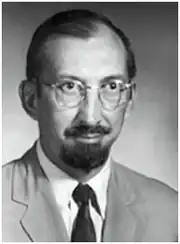D. R. Fulkerson
Delbert Ray Fulkerson (/ˈfʌlkərsən/; August 14, 1924 – January 10, 1976) was an American mathematician who co-developed the Ford–Fulkerson algorithm, one of the most well-known algorithms to solve the maximum flow problem in networks.
Delbert Ray Fulkerson | |
|---|---|
 | |
| Born | August 14, 1924 Tamms, Illinois, US |
| Died | January 10, 1976 (aged 51) Ithaca, New York, US |
| Alma mater | Southern Illinois University, University of Wisconsin–Madison |
| Known for | Ford–Fulkerson algorithm |
| Children | 2 sons |
| Awards | Lester R. Ford Award (1967)[1] of the Mathematical Association of America |
| Scientific career | |
| Fields | Mathematics |
| Institutions | RAND Corporation, Cornell University |
| Doctoral advisor | Cyrus MacDuffee |
| Doctoral students | Jon Folkman, Robert G. Bland |
Early life and education
D. R. Fulkerson was born in Tamms, Illinois, the third of six children of Elbert and Emma Fulkerson. Fulkerson became an undergraduate at Southern Illinois University. His academic career was interrupted by military service during World War II. Having returned to complete his degree after the war, he went on to do a Ph.D. in mathematics at the University of Wisconsin–Madison under the supervision of Cyrus MacDuffee, who was a student of L. E. Dickson. Fulkerson received his Ph.D. in 1951.[2]
Career
After graduation, Fulkerson joined the mathematics department at the RAND Corporation. In 1956, he and L. R. Ford Jr. described the Ford–Fulkerson algorithm.[3] In 1962 they produced a book-length description of their method.[4]
In 1971 he moved to Cornell University as the Maxwell Upson Professor of Engineering. He was diagnosed with Crohn's disease and was limited in his teaching. In despair, he committed suicide in 1976.[5]
Fulkerson was the supervisor of Jon Folkman at RAND and Tatsuo Oyama[6] at GRIPS. After Folkman committed suicide in 1969, Fulkerson blamed himself for failing to notice Folkman's suicidal behaviors.[7]
In 1979, the renowned Fulkerson Prize was established which is now awarded every three years for outstanding papers in discrete mathematics jointly by the Mathematical Programming Society and the American Mathematical Society.
References
- Fulkerson, D. R. (1966). "Flow networks and combinatorial operations research" (PDF). Amer. Math. Monthly. 73 (2): 115–138. doi:10.2307/2313544. JSTOR 2313544.
- "Delbert Ray Fulkerson" (PDF). library.cornell.edu. Retrieved 2014-07-01.
- Ford, L. R. Jr.; Fulkerson, D. R. (1956), "Maximal flow through a network" (PDF), Canadian Journal of Mathematics, 8: 399–404, doi:10.4153/cjm-1956-045-5, MR 0079251, S2CID 16109790.
- L. R. Ford; D. R. Fulkerson (1962). Flows in Networks. Princeton, NJ: Princeton University Press. ISBN 9780691079622.
- D. Ray Fulkerson from informs.org
- "OYAMA, Tatsuo | GRIPS Faculty Directory".
- Hoffman, Paul (1998), The Man Who Loved Only Numbers: The Story of Paul Erdős and the Search for Mathematical Truth, Hyperion, pp. 109–110, ISBN 978-0-7868-6362-4.
External links
- Delbert Ray Fulkerson prize
- Fulkerson biography at Cornell
- Delbert Ray Fulkerson at the Mathematics Genealogy Project
- Biography of D. R. Fulkerson from the Institute for Operations Research and the Management Sciences